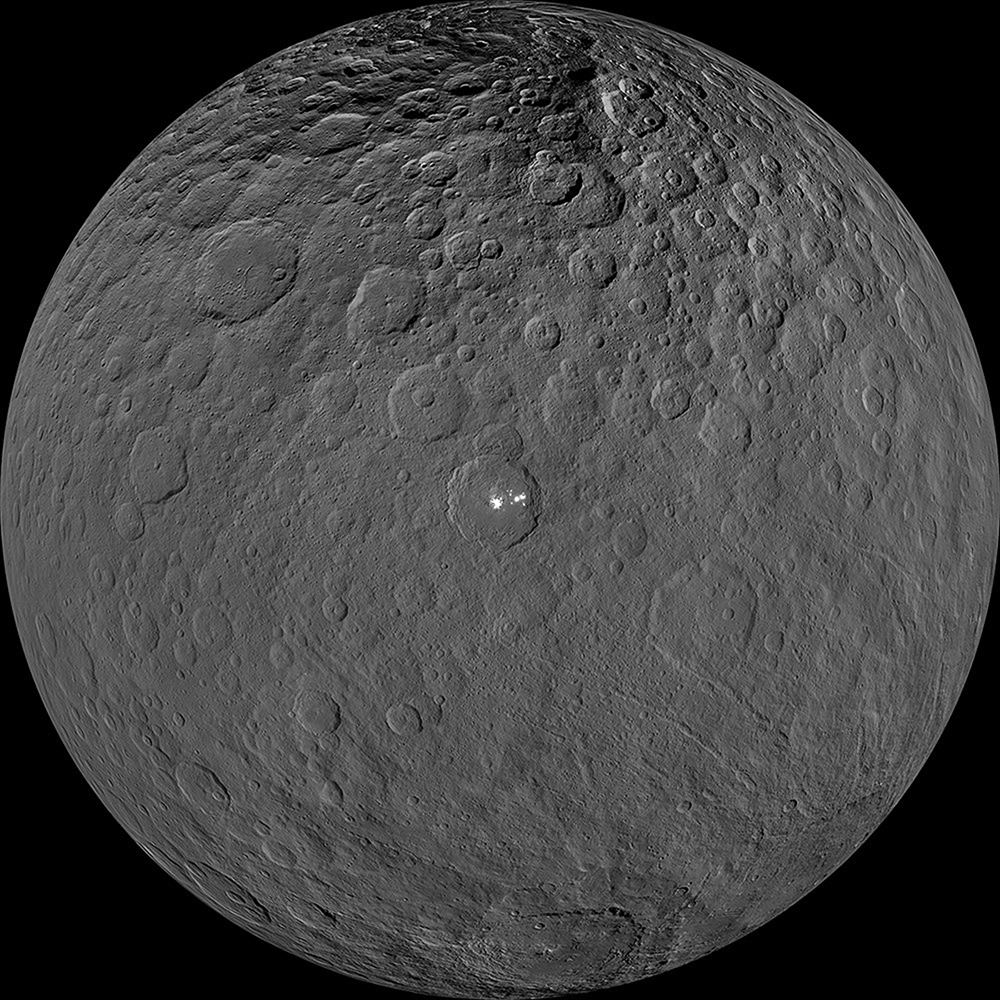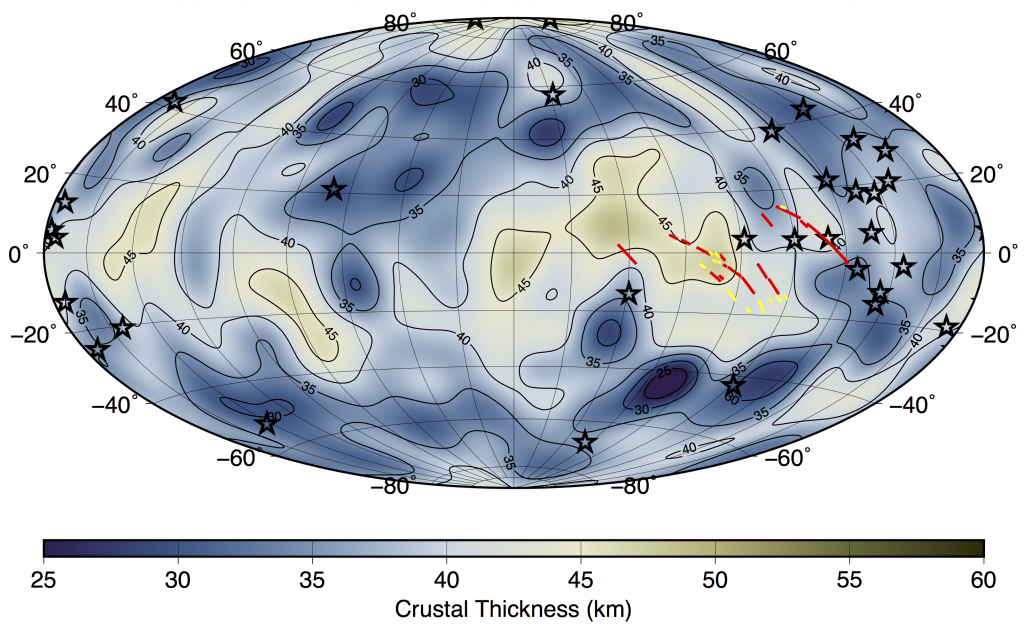Dr Scott King – The Dawn Mission: Casting New Light on Ceres
The dwarf planet Ceres is just a fraction of the size of Pluto, yet it holds valuable information about the evolution of our solar system. As a member of the Dawn mission team, Dr Scott King at Virginia Tech has been using data gathered by NASA’s Dawn spacecraft to explore the interior structure of Ceres.
A Primitive Planetary Body
Our solar system is not just planets orbiting around a star. There are many celestial bodies that we are continually discovering and exploring, such as asteroids, comets, moons and dwarf planets. Dwarf planets are particularly interesting objects, which offer scientists the opportunity to study worlds very different to Earth and provide clues about the evolution of our solar system.
The Dawn mission provided an exciting opportunity for scientists to study the dwarf planet Ceres in much greater detail than ever before. Very little is known about Ceres, particularly details of its internal structure, but scientists are very interested in its evolution because there is a significant proportion of water ice within its crust.
The search for water is closely linked to the search for extra-terrestrial life, but learning how Ceres evolved also gives clues about the early history of our solar system. Ceres is a primitive planetary body, which formed at a similar time to the other planets, but was never finished due to its close proximity to Jupiter. The pull of Jupiter’s gravity was so strong that material could not coalesce to continue forming Ceres as it did for the other rocky planets. Therefore, Ceres provides an exciting opportunity to study a planetary body that may be similar to the early Earth. Alongside his collaborators, Dr Scott King of Virginia Tech studies images and measurements of the surface of Ceres taken by the Dawn spacecraft during its Ceres orbit between 2015 and 2018. By combining this with computer simulations and models, they have been able to explore the internal structure of Ceres, and theorise how this mysterious world evolved.

Ceres as seen by NASA’s Dawn spacecraft. The projection is centred on the Occator Crater, home to the brightest area on Ceres. Occator is centred at 20 degrees north latitude, 239 degrees east longitude. CREDIT: NASA/JPL-Caltech/UCLA/MPS/DLR/IDA
Clues on Ceres’s Icy Surface
Ceres lies within the asteroid belt between Mars and Jupiter. For many years, it was considered to be an asteroid, but was re-classified as a dwarf planet in 2006, as it is much larger and rounder than the rocky asteroids around it. Ceres has a radius of 476 kilometres, and is thought to have a layered internal structure similar to that of the rocky inner planets. Early telescopic observations by scientists showed that up to 25% of its mass is likely to be made up of water ice, predominantly found in the crust.
Ceres has a highly cratered surface; however, the absence of very large craters suggests that some process may have reworked the original surface, which has intrigued scientists. The dwarf planet’s location means that many large asteroids would have hit it during its lifetime. This has led to the suggestion that an icy subsurface could be erasing evidence of craters due to its slow, viscous flow.
The Dawn spacecraft carried a framing camera, and by employing a technique known as stereophotogrammetry, the Dawn team was able to map the depths of the largest craters on Ceres, creating a digital terrain model. The researchers then applied a numerical simulation to discover how much crater walls have sunk, or ‘relaxed’, over billionyear timescales. Dr King describes how important computer simulations are for understanding the evolution of a planetary body. He suggests that computer simulations can use the observations of planetary bodies scientists make in the present, such as measuring heat signatures or the movement of tectonic plates, to model how specific aspects of that planet have changed over millions of years.
The Dawn team discovered that most of the large craters on Ceres are several kilometres deep, which would suggest that a slow slumping or relaxation of the crater walls has not yet occurred. This means that the crust on Ceres must be made of a material that is at least 1,000 times more viscous than water ice for impact craters to remain this deep over millions of years. Dr King suggests that there can be no more than 30–40% ice in the crust, and that this is mixed with rock material, salts, carbonates and possibly even clathrates (compounds where one molecule is trapped within the crystal structure of another). This combination would make the surface of Ceres much more viscous and consistent with the crater shapes the team observed.
The team did discover some anomalously shallow craters, which suggested there could be some areas of the surface that are more viscous than others. It is possible that the dwarf planet’s viscous crust may overlie a subsurface that is more deformable, containing water ice, or possibly even small amounts of liquid water left over from an ancient ocean on Ceres. This may account for the lack of older impact craters.

CREDIT: NASA/JPL-Caltech
Understanding the Interior
Dr King and his colleagues used the data provided from the Dawn spacecraft’s orbit of Ceres to confirm whether there is an inner core. The early telescopic studies of Ceres provided data from which scientists could estimate the density of Ceres. These studies indicate that the dwarf planet’s interior is likely arranged into an outer crust and at least one inner layer. By mapping the topography and features of the surface from images taken by the Dawn spacecraft, scientists have started to understand how internal layering may have evolved.
In a recent publication, Dr King and his colleagues were able to use computer simulations to model the interior of Ceres. By using over a hundred billion models with varying parameters, they were able to confirm that Ceres has a high-density core. They also discovered that the density of Ceres increases with depth. There is still some discussion as to the exact composition of the core, but Dr King suggests that it could be a combination of dry silicates (rocky minerals containing no water), along with heavier metallic minerals.
The Dawn team created a map of the features on the surface of Ceres, and identified a series of characteristics called pit chains. These are funnel-shaped pits formed by the drainage of impact materials into a subsurface void. These linear features, called the Samhain Catenae, consist of around six pit chains, totalling 1,211 kilometres in length.
The team used the spacing of these features, combined with experimental and computer modelling results, to estimate that the local thickness of the dwarf planet’s outer layer is at least 58 kilometres. This is around 14 kilometres greater than the previously calculated average thickness of the outermost layer. The Samhain Catenae are located close to another region with a similar thickness called Hanami Planum. In this location, scientists have also discovered a gravity anomaly – a difference in density between the outer crust and the underlying rock-rich layer.

A cutaway view of Ceres’ surface topography (in colour shading) with a superimposed temperature isosurface from one of Dr King’s 3D convection models. The hot plume (in tan) is shown rising beneath the high plateau (Hanami Planum), and the black lines represent the interpreted extensional faults, or Samhain Catenae (pit chains). Occator crater sits on the high plateau.
Evolution of the Interior
Data from the Dawn spacecraft has been vital to understanding the internal structure of Ceres. A core made of denser material compared to that found in the outer crust suggests that Ceres underwent differentiation soon after the dwarf planet formed. Differentiation is a process where materials separate into different layers according to how dense they are. This left a dense core of dry rock and metallic minerals, surrounded by less dense hydrated rock material and a thin crust made of a mixture of low-density materials.
NASA’s Dawn mission confirmed that there is a significant amount of water present on Ceres, particularly at the surface, locked within icy deposits and rocky minerals with water in their crystal structure. This supports the theory that Ceres once had a watery ocean, and there are ocean remnants remaining within the crust and shallow subsurface.
Dr King and his colleagues also propose that Ceres might be a dynamic planetary body – a planet where internal processes can affect the surface. There is evidence of convection within the dwarf planet’s rocky interior that could have caused some of the variation in topography and thickness of the crust. This is similar to the process within the Earth where hot mantle slowly deforms and over long timescales acts like a viscous liquid even though it is solid.

Crustal Thickness map of Ceres. Red/yellow lines are the Samhain Catenae (pit chains). Stars indicate the locations of large domes.
The small size of Ceres means that unlike the Earth, Mars or even the Moon, Ceres did not have enough heat when it formed to power this viscous motion. Instead, heat was generated by radioactivity over time, gradually warming the interior until it became unstable. This could result in a single large area of upwelling, called a plume. The team proposes that this plume could alter the topography in the outermost crust, resulting in the pit chain formations of Samhain Catenae. It would also account for the thicker crust at Hanami Planum, along with the gravity anomaly that the Dawn spacecraft measured.
The possibility that a dwarf planet such as Ceres might be a dynamic body despite being much smaller than other geologically active bodies in the solar system is an exciting revelation. It was thought that Ceres was too cold for internal convection to occur. Evidence of an upwelling plume, along with the potential presence of liquid water, will help scientists to better understand how early Earth may have evolved. It may also suggest new locations to find liquid water in our solar system and beyond. Liquid water might be present below the surface of Ceres, as the presence of salt lowers the freezing temperature of water. The Dawn mission has provided a wealth of information that scientists continue to analyse in order to further our understanding of the early solar system.
Reference
https://doi.org/10.33548/SCIENTIA410
Meet the researcher

Dr Scott King
Virginia Tech Geosciences
Blacksburg, VA
USA
Dr Scott King is Professor of Geophysics at Virginia Tech, with a particular research interest in combining numerical models with topography, gravity and seismic measurements to understand plate tectonics and the internal structure of planetary bodies. He was selected as a Guest Investigator for NASA’s Dawn mission to Ceres, but has also worked on the evolution of Mercury, Venus, Earth, and Mars. Since completing his PhD at the California Institute of Technology, Dr King has had an extensive research career resulting in over 80 publications. He is a Fellow of the Geological Society of America and in 2009 received the Alexander von Humboldt Research Award.
CONTACT
E: sdk@vt.edu
W: http://scottdking.wordpress.com
KEY COLLABORATORS
Michael Bland (USGS Flagstaff, AZ)
Julie Castillo-Rogez (JPL, Pasadena, CA)
Carol Raymond (JPL, Pasadena, CA)
PARTICIPATING INSTITUTES
The Dawn mission is managed by the Jet Propulsion Laboratory for NASA’s Science Mission Directorate in Washington. Dawn is a project of the directorate’s Discovery Program, which is managed by NASA’s Marshall Space Flight Center in Huntsville, Alabama. The University of California at Los Angeles (UCLA) is responsible for overall Dawn mission science. The German Aerospace Center, the Max Planck Institute for Solar System Research, the Italian Space Agency and the Italian National Astrophysical Institute are international partners on the mission team.
FURTHER READING
SD King, JC Castillo-Rogez, MJ Toplis, MT Bland, CA Raymond, and CT Russell, Ceres internal structure from geophysical constraints, Meteoritics and Planetary Science, 2018, 53, 1999–2007.
RR Fu, A Ermakov, S Marchi, JC Castillo-Rogez, BH Hager, RA Raymond, MT Bland, MT Zuber, SD King, RS Park, CT Russell, Interior structure of the dwarf planet Ceres as revealed by surface topography, Earth and Planetary Science Letters, 2017, 476C, 153–164.
CT Russell, CA Raymond, E Ammannito, DL Buczkowski, MC De Sanctis, H Hiesinger, R Jaumann, SD King, AS Konopliv, HY McSween, A Nathues, RS Park, CM Pieters, TH Prettyman, TB McCord, L McFadden, S Mottola, MT Zuber, SP Joy, C Polanskey, MD Rayman, JC Castillo-Rogez, PJ Chi, JP Combe, A Ermakov, M Hoffmann, YD Jia, J-Y Li, S Marchi, F Preusker, T Roatsch, O Ruesch, P Schenk, MN Villarreal, N Yamashita, Dawn arrives at Ceres: Exploration of a small volatile-rich world, Science, 2016, 353, 6303, 1008–1010.
MT Bland, CA Raymond, PM Schenk, RR Fu, T Kneissl, JH Pasckert, H Hiesinger, F Preusker, RS Park, S Marchi, SD King, JC Castillo-Rogez, CT Russell, The composition and structure of Ceres’ as revealed by its largest craters, Nature Geosciences, 2016, 9, 538–542.


Creative Commons Licence
(CC BY 4.0)
This work is licensed under a Creative Commons Attribution 4.0 International License. 
What does this mean?
Share: You can copy and redistribute the material in any medium or format
Adapt: You can change, and build upon the material for any purpose, even commercially.
Credit: You must give appropriate credit, provide a link to the license, and indicate if changes were made.
More articles you may like
Grandmothers: Innovation Through Tradition
Grandmother Project – Change through Culture (GMP) is an organisation dedicated to documenting the role of grandmothers and demonstrating the effectiveness of grandmother-inclusive strategies in improving the health and well-being of women, children, and adolescents. GMP’s groundbreaking work challenges conventional wisdom to transform community-based interventions in Africa and beyond, harnessing a powerful but often overlooked resource: the wisdom and influence of grandmothers.
Dr Robert Larkin | Cultivating Change to Improve Soil Health and Increase Potato Yield
Environmental quality and food production are facing the pressing challenges of climate change and global population growth. Dr Robert Larkin from the United States Department of Agriculture-Agricultural Research Service (USDA-ARS) and a team of plant scientists developed and tested a range of crop management systems to help overcome these compounding challenges. Their work is improving soil health and increasing the yield of potato crops, contributing to the future food security of nations.
Professor Giorgio Buttazzo | Artificial Intelligence and a Crossroads for Humanity
Where do we stand with artificial intelligence? Might machines take over our jobs? Can machines become conscious? Might we be harmed by robots? What is the future of humanity? Professor Giorgio Buttazzo of Scuola Superiore Sant’Anna is an expert in artificial intelligence and neural networks. In a recent publication, he provides considered insights into some of the most pressing questions surrounding artificial intelligence and humanity.
Dr Ralf Adam | New Technologies Shaping the Future of Oral Hygiene
Understanding the efficiency of various toothbrush technologies is essential for achieving optimal oral health. Dr Ralf Adam, who leads a dedicated team at Procter & Gamble in Germany, is keen to investigate the complexities of these technologies. His team have provided new insights into the best toothbrush types for plaque removal and the maintenance of gum health. By highlighting the importance of informed oral care decisions and ongoing investigations, this vital research works towards ensuring everyone can achieve a brighter, healthier smile.




